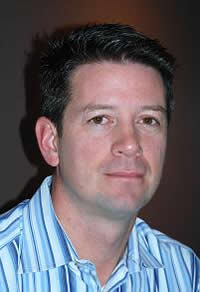New Project is the ACME of Addressing Climate Change
Berkeley Lab to help accelerate development of state-of-the-science Earth system models
August 25, 2014
Dan Krotz, 510-486-4019, dakrotz@lbl.gov

Hans Johansen, CRD Applied Numerical Algorithms Group
High performance computing will be used to develop and apply the most complete climate and Earth system model to address the most challenging and demanding climate change issues.
Eight Department of Energy national laboratories, including Lawrence Berkeley National Laboratory, are combining forces with the National Center for Atmospheric Research, four academic institutions and one private-sector company in the new effort. Other participating national laboratories include Argonne, Brookhaven, Lawrence Livermore, Los Alamos, Oak Ridge, Pacific Northwest and Sandia.
The project, called Accelerated Climate Modeling for Energy, or ACME, is designed to accelerate the development and application of fully coupled, state-of-the-science Earth system models for scientific and energy applications. The plan is to exploit advanced software and new High Performance Computing machines as they become available.
The initial focus will be on three climate change science drivers and corresponding questions to be answered during the project’s initial phase:
- (Water Cycle) How do the hydrological cycle and water resources interact with the climate system on local to global scales? How will more realistic portrayals of features important to the water cycle (resolution, clouds, aerosols, snowpack, river routing, land use) affect river flow and associated freshwater supplies at the watershed scale?
- (Biogeochemistry) How do biogeochemical cycles interact with global climate change? How do carbon, nitrogen and phosphorus cycles regulate climate system feedbacks, and how sensitive are these feedbacks to model structural uncertainty?
- (Cryosphere Systems) How do rapid changes in cryospheric systems, or areas of the earth where water exists as ice or snow, interact with the climate system? Could a dynamical instability in the Antarctic Ice Sheet be triggered within the next 40 years?
Over a planned 10-year span, the project aim is to conduct simulations and modeling on the most sophisticated HPC machines as they become available, i.e., 100-plus petaflop machines and eventually exascale supercomputers. The team initially will use U.S. Department of Energy (DOE) Office of Science Leadership Computing Facilities at Oak Ridge and Argonne national laboratories.
The model will also be optimized for deployment on the National Energy Research Scientific Computing Center (NERSC), which is located at Berkeley Lab.
“We need a new paradigm for how to develop and apply climate models to answer critical questions regarding the implications of our past and future energy choices for society and the environment,” says Bill Collins, ACME’s Chief Scientist and head of the Earth Sciences Division’s Climate Sciences Department at Berkeley lab.
“To address this critical need, ACME is designed to accelerate our progress towards actionable climate projections to help the nation anticipate, adapt to, and ultimately mitigate the potential risks of global climate change,” Collins adds.
Berkeley Lab scientist Bill Collins is the ACME Chief Scientist, with duties to lead the overall scientific direction of the project. He is working with the rest of the team to ensure that ACME can fully exploit the world-leading computers deployed by the Department of Energy.
To address the water cycle, the Project Plan (link below) states that changes in river flow over the last 40 years have been dominated primarily by land management, water management and climate change associated with aerosol forcing. During the next 40 years, greenhouse gas (GHG) emissions in a business as usual scenario will produce changes to river flow.
“A goal of ACME is to simulate the changes in the hydrological cycle, with a specific focus on precipitation and surface water in orographically complex regions such as the western United States and the headwaters of the Amazon,” the report states.
To address biogeochemistry, ACME researchers will examine how more complete treatments of nutrient cycles affect carbon–climate system feedbacks, with a focus on tropical systems; and investigate the influence of alternative model structures for below-ground reaction networks on global-scale biogeochemistry–climate feedbacks.
For cyrosphere, the team will examine the near-term risks of initiating the dynamic instability and onset of the collapse of the Antarctic Ice Sheet due to rapid melting by warming waters adjacent to the ice sheet grounding lines.
The experiment would be the first fully coupled global simulation to include dynamic ice shelf–ocean interactions for addressing the potential instability associated with grounding line dynamics in marine ice sheets around Antarctica.
Other Berkeley Lab researchers involved in the program leadership include Will Riley, an expert in the terrestrial carbon cycle and co-leader of the Biogeochemical Experiment Task Team. Hans Johansen, a computational fluid dynamicist, is co-leader of the Computational Performance Task Team.
Initial funding for the effort has been provided by DOE’s Office of Science.
More information can be found in the Accelerated Climate Modeling For Energy: Project Strategy and Initial Implementation Plan.
About Berkeley Lab
Founded in 1931 on the belief that the biggest scientific challenges are best addressed by teams, Lawrence Berkeley National Laboratory and its scientists have been recognized with 16 Nobel Prizes. Today, Berkeley Lab researchers develop sustainable energy and environmental solutions, create useful new materials, advance the frontiers of computing, and probe the mysteries of life, matter, and the universe. Scientists from around the world rely on the Lab’s facilities for their own discovery science. Berkeley Lab is a multiprogram national laboratory, managed by the University of California for the U.S. Department of Energy’s Office of Science.
DOE’s Office of Science is the single largest supporter of basic research in the physical sciences in the United States, and is working to address some of the most pressing challenges of our time. For more information, please visit energy.gov/science.









